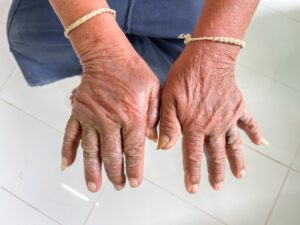Tennis elbow, quarterback shoulder, and jumper’s knee are common names for the same condition: tendonitis. Tendonitis is a painful but often preventable injury. It is your body’s way of telling you that you are putting too much stress on this muscle and joint.
Tendons are a type of connective tissue that attach muscles to bones. When muscles contract, tendons pull on the bones to cause movement. Although tendons can withstand a lot of stress, too much pressure on the joints can cause them to tear and become inflamed. Thankfully, if the damage done is minor or only happens occasionally, the tissue has the ability to heal itself. However, if the damage is frequent, the pain may become persistent.
Athletes know that tendonitis is a common result of overdoing it, especially when the body is out of shape. Other factors contribute to tendonitis:
- Forceful or violent motions, such as baseball pitching
- Unnatural motions like serving a tennis ball
- Poor body mechanics or technique when doing an activity like aerobics, lifting weights, or painting the ceiling
- Chronic inflammation from Rheumatoid Arthritis or other similar types of arthritis
- Often several of these factors may be involved at once.
Is It Tendonitis? Acute vs. Chronic Tendonitis
Tendinosis is a long-term issue caused by either repetitive stress or an unresolved injury. It presents as a dull, persistent ache that intensifies when movement is initiated but gets better as the muscles warm up.
Tendonitis is an acute condition in which a direct injury to a tendon causes inflammation and sharp pain that may prevent movement of the joint. Tendonitis can also be triggered by chronic inflammation from Rheumatoid Arthritis or other similar types of arthritis. Although the pain may eventually subside, it is likely to return if the stressful motion is done again or during an RA flare-up.
Treating Tendonitis
Most tendonitis symptoms can be treated at home using the RICE treatment method for pain relief: Rest, Ice, Compression, and Elevation. This treatment can help speed recovery and help prevent more problems.
- Rest. Avoid doing things that increase pain or swelling. Don’t try to work or play through the pain. Healing requires rest, but not complete bed rest. You can do other activities and exercises that don’t stress the injured tendon. Low-impact movements like swimming and water exercise may be good options.
- Ice. To decrease pain, muscle spasms, and swelling, apply ice to the injured area for up to 20 minutes several times daily.
- Compression. Because swelling can cause loss of motion in an injured joint, wrap the area tightly until the swelling stops. Use wraps or elastic bandages.
- Elevation. Raise the injured area above the level of your heart to reduce swelling.
Our doctors may suggest taking over-the-counter pain medications such as aspirin, naproxen, or ibuprofen. To further strengthen the muscles around the sore joint, start exercising within a day or two. Make sure to begin with a warm-up to reduce any shock to the tissues. Then, begin lifting light weights or using an elastic exercise band to build up your strength. You can slowly increase the intensity as you feel the tendon are surrounding area has healed enough. Stretching is also an essential part of the treatment – hold each stretch for 20-30 seconds, repeating 3-5 times. Sometimes, physical therapy may be necessary to help reduce pain and improve function of the affected tendon.
Preventing Tendonitis
A prevention program should promote a safe and healthy workout:
- Warm up thoroughly, gradually building the intensity level of your workout. Proper stretching prior to engaging in exercise is also important. Cool down after the session.
- Train for a new sport before you start it. Start building strength and flexibility in the muscles you will use a few weeks or months in advance.
- Learn the proper method and use the appropriate equipment for any exercise or activity. Work out regularly, not just once a week.
Pacific Arthritis is a group of rheumatology experts in Los Angeles and Santa Monica who specialize in diagnosing and treating tendonitis. Our experienced team is dedicated to providing immediate and long-lasting relief for your pain and symptoms. If you or a loved one is experiencing tendonitis symptoms, call (310) 297-9221 to schedule an appointment.






